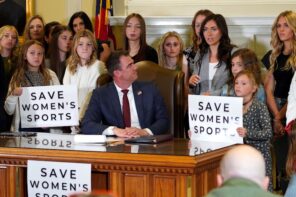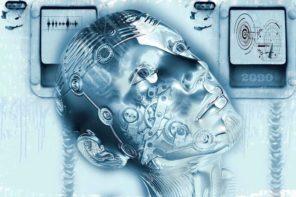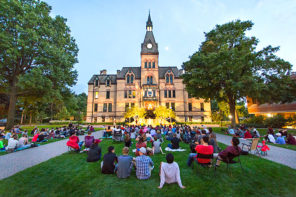A coalition of civil rights organizations just released “Mapping Muslims: NYPD Spying and its Impact on American Muslims” which pulls together what we know of the NYPD surveillance of Muslim communities throughout the Northeast, places the surveillance in a legal context, and more importantly, interviews Muslims to understand the real world impact of the surveillance.
We already know that it has produced no intelligence related to terror activity of any sort, and it’s not clear if it produced any information about any criminal activity at all. However, despite the fact that NYPD surveillance has turned up nothing, and that years of reports by the Triangle Center on Terrorism and Homeland Security have shown that Muslim terrorism is not a threat after 9/11, the NYPD still turns to the defense that if Muslims have nothing to hide, they shouldn’t care about the violation of their rights. This is the rationale used by totalitarian states where everyone is to be open to the state on demand. Only a cursory knowledge of American history and a skim of the Constitution are required to see how un-American this is.
The report traces the NYPD’s fear of minority communities back to 1904 with the creation of the “Italian Squad” whose purpose was to track the activities of Italian immigrants (pg. 7). In this regard, New York Muslims are going through a fairly ordinary ritual. What isn’t ordinary are the methods, the cost to real crime prevention, and the ways in which the NYPD is arrogating new powers for itself that jeopardize the freedom of all New Yorkers.
Take this passage on page 10, for example:
[W]here the NYPD was spying in Arab neighborhoods with sizeable populations of Syrian Jews and Egyptian Christians, the intelligence unit explicitly focused on the Muslim populations.
The surveillance was going on at a time when a (non-Muslim) Syrian community in Brooklyn was being investigated by the FBI for ties to organ trafficking and political corruption, yet the NYPD was not involved.
When Muslims would go to the NYPD to report a crime they were interrogated by the so-called “Demographics Unit”; so the NYPD was not only surveilling individuals without cause, but it investigated victims of crimes who came to the NYPD to report those crimes. Paired with the assertion in the NYPD’s report, Radicalization in the West, that one of the markers of a potential terrorist is that s/he does not drink alcohol, and you have the premises for police overreach.
It’s difficult to imagine the NYPD asserting that Catholics who fast during Lent are potential terrorists, the way it suggests that Muslims who fast during Ramadan are. The great unspoken folly of the radicalization report is that it applies equally well to Orthodox Jews as it does to certain Muslim communities.
Perhaps the greatest contribution the report makes is to see how the surveillance is damaging the lives of New Yorkers. Spiritual leaders are afraid to meet with congregants (pg. 15) and congregants are afraid to pray in public (pg. 12-13). One woman even states that her mother would rather go back to war-torn Yemen than deal with the NYPD, so strong is her fear of police abuse (pg. 29).
And the damage being done to college students is unforgivable:
[F]or college students, typically aged between 17 and 22, the prospect of dealing with surveillance by a police department, infiltration of events and extracurricular activities by informants, and the potentially devastating academic, professional, and personal repercussions can be overwhelming (pg. 40).
Students fear making friends on campus, because they do not trust that the person they are speaking to is not a spy. They curtail their speech in class, and do not worship freely. MSAs actively discourage students from speaking at community gatherings, and there is no reason to believe that campus spiritual leaders are not self-censoring as well. The NYPD’s actions are actively tearing down these individuals and preventing them from engaging intellectually or spiritually with college life.
Of course, while the report focuses on Muslims, there is a clear pattern of a more generalized NYPD abuse of power, including approaching young children to act as informants (pg. 27), which makes it less surprising that the NYPD would handcuff and detain a seven-year-old as a criminal element for hours and without granting access to his parents.
Vehicular accidents go uninvestigated in New York because the NYPD finds it too much work to look for people who hit pedestrians and they believe that they have no special duty to keep New Yorkers safe if they witness a violent assault, yet they simultaneously maintain that the best way to keep New Yorkers safe is to spy on Muslims. In addition, the NYPD ignores locations of repeated criminal activity, allowing businesses to be ransacked multiple times. But they’re perhaps most notorious for their discredited stop-and-frisk policy that harasses people of color, with a negligible preventive return.
The coalition behind the report has partnered with other other groups to demand legislative redress to these gross violations. We need an Inspector General at the state level; as I’ve written about before, I think Ray Kelly is too powerful within the city for us to have truly independent oversight. The fact that the NYPD feels comfortable lying to New Yorkers on a regular basis means we need external eyes on the department.
We need to know that information on non-criminal activity is not being retained and that the NYPD has not been diverting funds from crime fighting to support a misguided crusade (a term I do not use lightly) to harass New York’s people of color. And it wouldn’t hurt for the Department of Justice to initiate an investigation.




